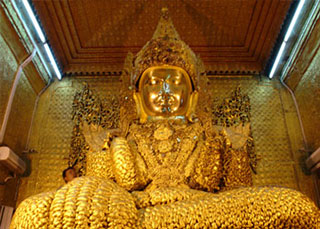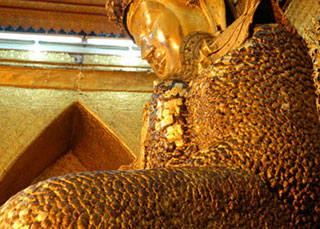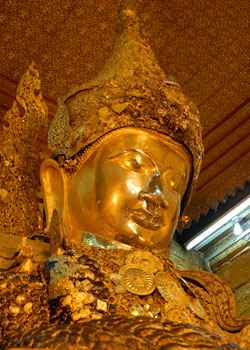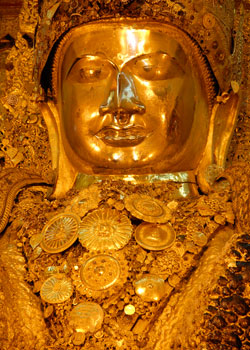One of the musts in your itinerary in Mandalay. the last Capital of old Myanmar should be Maha Muni. the largest gold Buddha Image housed in a gilt brick temple of late 19th century architectural design. situated in the south-west township.
The two Pali words Maha Muni meaning “the Great Exalted Saint “. is one of the attributes of the Buddha. But the Mandalayans call it ‘ Hpaya-gyi ‘ (the great Buddha ) because of its superlative size. Brought from Mrohaung in the Rakhine State by land over the mountain ranges. and by water via the Ayeyarwaddy River. in A . D 1784 by the son and heir of King Bodawpaya ( A.D.1782-1819 ) the sacred Image was housed in a big ornate building constructed at the then Capital. Amarapura. In A.D 1884 the building caught fire but the sacred Image was miraculously saved. Originally it was an alloy. but now it is heavily gilded.


It is estimated that nearly two tons of gold is encrusted on it. The gold crown and the body ornaments it wears are solid gold with several precious germs studded on – rubies. sapphires. emeralds. jades. diamonds. pearls etc donated by pious devotees. Representing the Lord Buddl1a in a sitting-posture with legs folded under the body. the Image rests on a masonary pedestal six feet. ten inches high. The dimensions of the Image itself taken in 1917 are:
Description of part Feet Inches
Height 12 7
Waist 9 6
Arms 4 11
Width from shoulder 6 1
Width at base 9 0
But since that date years of daily gilding have changed the above measurements. The Image is now massive with gold foil.
The image is reputed to be of very great antiquity. Its legend says that it was cast during the visit of the Lord Buddha who exhaled his breath into the Image. So it was blessed and consecrated by the Lord Buddha. But the Rakhine Chronicles claim that ” in the year A.S. 146 a king named Chandrasuriya came to the throne of the Rakhine State… In His reign a metal image of the Buddha was cast.”It is an object of fervent adoration to Buddhists he world over. The solid gold canopy installed above the Image is a recent one. weighing 18viss. In the last few years. the Mandalayans donated four votive pieces of solid gold — an alms bowl. a food container. a water ewer. and a stemmed salver. The temple which houses the Image has a terraced roof of gilt stucco which is of modern construction but of classical design.


The original roof was destroyed by fire in 1884. Four entrances facing the four cardinal points lead to the central shrine. The passages were once adorned with frescoes; those on the northside depicted the event of bringing the Image from the Rakhine State to Amarapura owing to repairs and renovations many of these have been wiped out and only a few remain. In the inner precinct are set up a number of inscribed stone slabs. collected by order of King Bodawpaya. with copies of inscriptions recording religious endowments.
Not far from the western entrance is a group of bronze figures. two of men. three of lions. and one of a three headed elephant housed in a square brick hall. They were brought from the Rakhine State at the same time as the Maha Muni Image . Originally. the bronze figures were Khmer. taken to Ayuthia. when Siam won the war with Cambodia. In A.D 1553. whin King Bayint Naung returned in triumph from Ayuthia he brought them to his Capital Hamsawaddi. Pegu. In A.D.1660 when King Razagyi of Rakhine State invaded Hamsawaddi Pegu he took them to his Capital Mrauk U. dyspeptics seek to cure their ailment by thrusting their fingers into the navels of the human figures and twisting them round and round.
Next to them are two of the largest gongs of bronze. one in triangle shape called ” Kyey – si” and the other a circular one called ” Maung ” each housed in a separate hall. They were cast a few decades ago . Because of their great size. They were not allowed to function but are kept stationary. The history of the casting of these two gigantic votive objects may be read on the billboards inside the halls.
On the south – east of the Temple is a large tank of turtles. Wherein Buddhists let fish or turtles go free as an act of life saving charity. The Maha Amuni Image was accompanied by numerous Image attendants and familes of service men who were settled in the areas around the Temple. In the courtyard on the north – east of the precinct. there stands a stone inscription recording the manner in which the image was brought from the Rakhine State.
Well. readers. come see for yourselves and marvel at these Myanmar Superlatives.
Dr. Khin Maung Nyung
